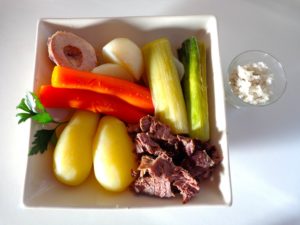
Pot au feu
This classic French dish of beef and veggies takes time to prepare but there is no fancy dancing involved. The meat is boiled for several hours to create a rich, flavorful broth, and the carrots, turnips, leeks and potatoes are added at the end. Serving is a two-stage affair — first the broth, then the beef and veggies, often accompanied by little dishes of sea salt, Dijon mustard and/or cornichons (small, sour French pickles).
One benefit of this dish is that, beyond being healthy, it is remarkably inexpensive to make. Stewing beef is used — generally a couple of varieties, such as round (gîte), short ribs (plat de côtes), rump (culotte), chuck (paleron) or brisket (poitrine). Please note that French cuts of beef are not equivalent with American/English cuts. The point is to use beef that can withstand lengthy cooking, with some fat and gristle attached. The fat will be skimmed off after the beef is boiled, while the gristle adds gelatin to the broth.
As for the veggies, some versions of pot au feu (literally ‘pot on the fire’) add parsnips, celeriac, celery and/or cabbage to the vegetables listed above. Feel free to improvise, although I’d be cautious about using cabbage, which tends to take over the dish.
As preparation is quite lengthy, you can make pot au feu over two days. On the first day, boil the beef to create the broth. Refrigerate overnight, and finish the dish the next day. This has the advantage of allowing easy removal of the chilled fat from the broth.
The quantities below will serve four people.
1 pound (500 g) thick-cut round steak (gîte)
1 pound (500 g) short ribs (plat de côtes)
1 large onion
3 cloves
5 carrots (1 of them for the broth)
2 garlic cloves
1 bay leaf
2 sprigs of thyme
4 sprigs of parsley
1 tablespoon sea salt or table salt
8 black peppercorns
3 turnips
2 leeks
4-6 boiling potatoes
2-3 marrow bones (optional)
Place the beef in a large soup pot. Cover with water to a level about an inch (2.5 cm) above the surface of the meat (about two quarts/liters). Bring to a boil, turn down the heat and simmer for one hour, skimming off the foam from time to time.
Peel the onion, leaving it whole. Stud with the cloves. Peel one carrot, removing the ends. Peel the garlic. When the beef has cooked for an hour, add these vegetables to the pot. Add the bay leaf, thyme, parsley, salt and peppercorns. Simmer for three hours more, topping up with water as necessary.
Pour the broth through a colander into a clean pot. Remove the beef from the colander and set aside. Discard the remaining contents of the colander. You should now have a clear broth. Refrigerate for an hour, or overnight, to allow the fat to harden. Pour the broth through a fine sieve to remove the fat before resuming the recipe.
Return the beef and broth to your (cleaned) large soup pot. Add water to cover the beef as necessary. Bring to a simmer.
While the broth is heating, pare the remaining carrots, peel the turnips and chop in half, cut the leeks into four-inch (10-cm) segments and peel the potatoes.
Add the carrots and turnips to the simmering broth. Wait 10 minutes and add the leeks. Cook for 20 minutes more.
Meantime, place the potatoes in a separate pot of cold water and bring to a boil. Cook until tender, about 20 minutes.
If using marrow bones, ladle about an inch (2.5 cm) of broth into a separate pot, bring to a simmer, add the bones and cook for 10 minutes, turning them over halfway through.
You are now ready to serve your creation. Several steps are involved.
1) Remove the beef, trim off most of the fat and cut into slices. This can be tricky as the beef will be so tender that it’s falling apart. Never mind, small slices are fine.
2) Pass the remaining contents of the soup pot through a sieve into a smaller clean pot to filter the broth. Return the beef and veggies to the large soup pot with a couple ladles of broth. Set over very low heat to keep warm.
 3) Reheat the smaller pot of broth briefly. Serve in shallow bowls, decorated with a sprig of parsley and accompanied by crusty bread and hearty red wine (e.g. Bordeaux or Côtes du Rhone).
3) Reheat the smaller pot of broth briefly. Serve in shallow bowls, decorated with a sprig of parsley and accompanied by crusty bread and hearty red wine (e.g. Bordeaux or Côtes du Rhone).
4) Arrange the warm beef on a platter with the veggies and marrow bones. Bring to the table, along with a small dish of sea salt, some Dijon mustard and/or cornichons. Enjoy.
You can follow the pot au feu with a green salad, a cheese plate and fresh fruit or a dessert.
The recipe serves four, or if fewer people are present you can reheat the pot au feu the next day — it will be even better.




